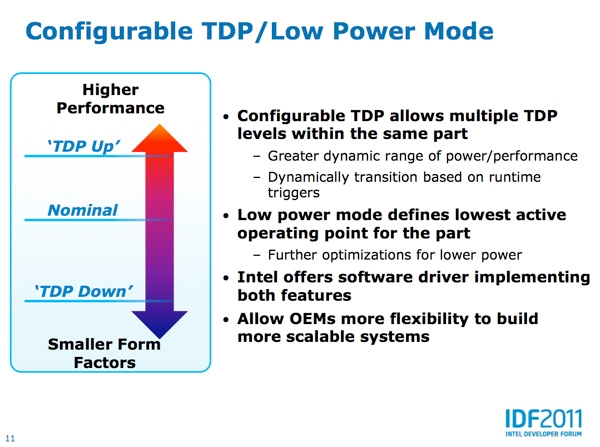Configurable TDP & Other Power Optimizations
The move to a 22nm process and Tri-Gate transistors alone should already account for some pretty significant power savings. But there are a few other changes in Ivy Bridge meant to optimize power consumption.
An important addition brought to mobile Ivy Bridge processors is the inclusion of a configurable TDP that allows them to switch between three different ratings: nominal, a lower configurable TDP and an upper configurable TDP. Ultra low voltage (ULV) parts will be rated at 17W, similar to existing ULV Sandy Bridge processors, but can go up to 25W – with a corresponding rise in performance – when running under mains power, or when it's connected to a docking station that increases the amount of cooling to dissipate the additional heat.

This goes beyond Intel's existing Turbo Boost feature as it exceeds the CPU's nominal TDP, whereas current Sandy Bridge chips are mostly bound by it. Likewise, a 17W ULV processor could go down to a mere 14W to save battery life when running light tasks on the go. Besides ULV chips, extreme edition mobile Ivy Bridge processors will also support configurable TDP, with 55W parts able to go up to 65W or down to 45W.
| cTDP Down | Nominal | cTDP Up | |
|---|---|---|---|
| Ivy Bridge ULV | 14W | 17W | 25W |
| Ivy Bridge XE | 45W | 55W | 65W |
Configurable TDP will be exclusive to mobile processors as far as we know. All models can go down in terms of TDP, but not all will be able to go up. Also, notebook manufacturers would presumably have some freedom to "configure" the chip around the system they want to build rather than doing it the other way.
For desktops, TDP will come in 35W, 45W, 55W, 65W, and 77W options, according to the latest leaked Ivy Bridge roadmaps, down from the current peak of 95W for non-Extreme Sandy Bridge parts.
Lower System Agent Voltages: The System Agent is the uncore area of the CPU die containing the display output, memory controller, DMI and PCI Express interfaces. It operates on a separate voltage plane than the rest of the chip and with Ivy Bridge Intel will be able to power optimize some SKUs – likely ULV processor models – even further with lower System Agent operating voltages.
Power Aware Interrupt Routing (PAIR): This feature is meant to improve Intel's core sleeping technology by making the CPU aware of which of its cores are asleep and which are awake. It can then send interrupt requests from peripherals or a software application to cores that are up and running, rather than waking a core that has been powered down to handle the interrupt.
Support for DDR3L on mobile CPUs: Intel upgraded the dual-channel DDR3 memory controller of mobile Ivy Bridge to accept ultra-low voltage DDR3, or DDR3L, which could shave a few extra watts from a system's total power draw. Ivy Bridge will also switch off the DDR I/O to save power when idle.
Optimized voltage choice for all operating frequency points: Like Sandy Bridge, Ivy Bridge can vary its operating frequency depending on the task at hand, and Intel will use the lowest voltage possible for each one of those frequencies. The chipmaker says it has fine tuned this even further with Ivy Bridge.
